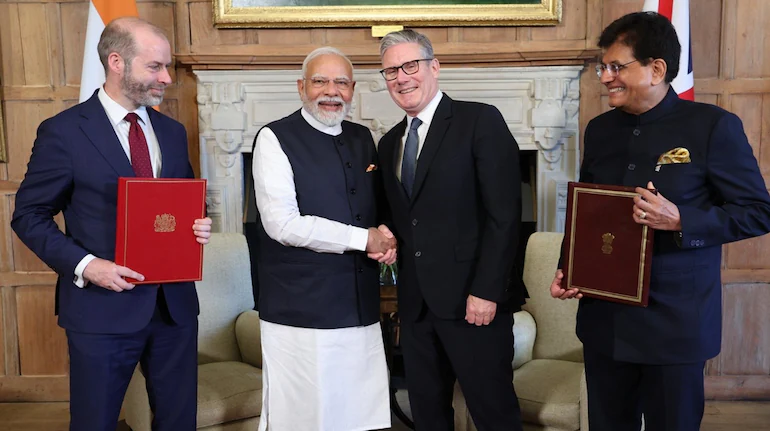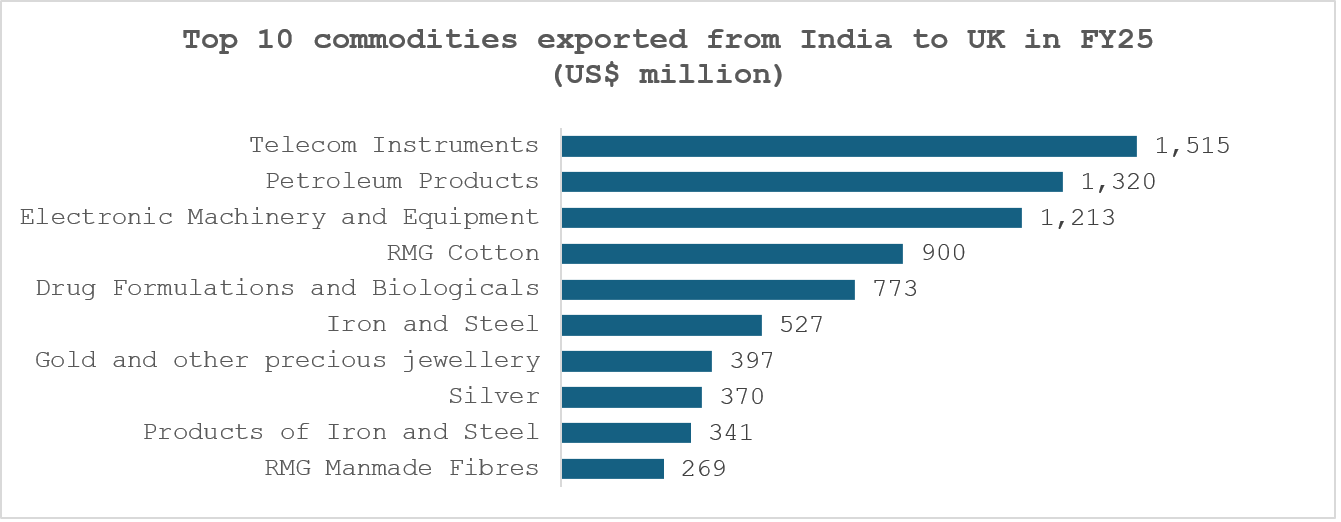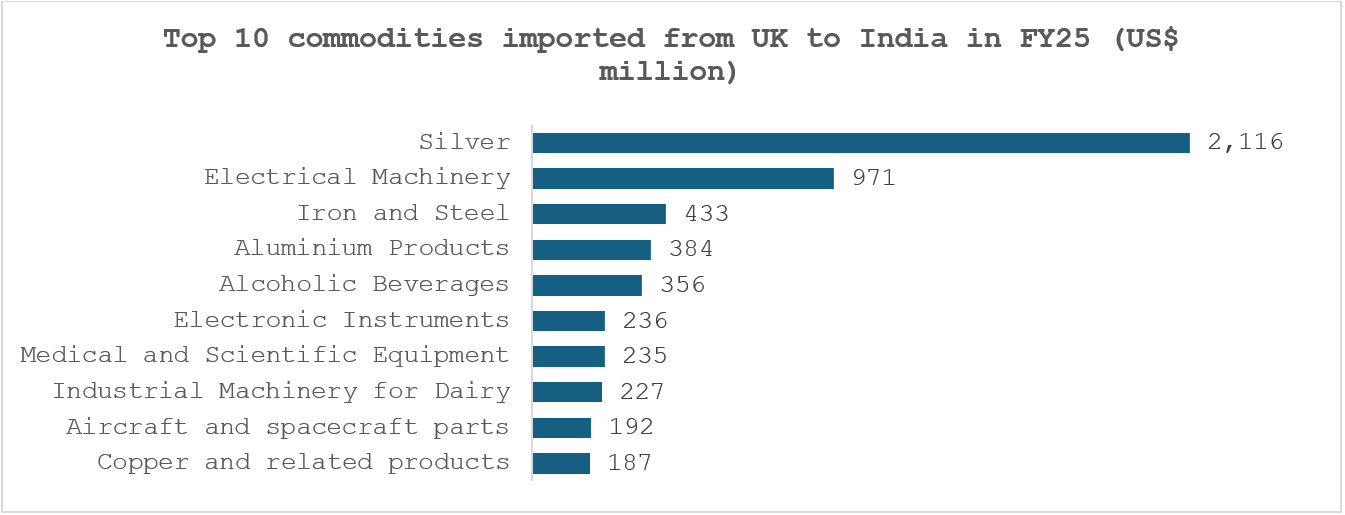SEARCH
RECENT POSTS
Categories
- Agriculture (31)
- Automobiles (18)
- Banking and Financial services (33)
- Consumer Markets (51)
- Defence (6)
- Ecommerce (21)
- Economy (68)
- Education (13)
- Engineering (6)
- Exports (21)
- Healthcare (24)
- India Inc. (8)
- Infrastructure (29)
- Manufacturing (28)
- Media and Entertainment (15)
- Micro, Small & Medium Enterprises (MSMEs) (15)
- Miscellaneous (30)
- Perspectives from India (33)
- Pharmaceuticals (4)
- Railways (4)
- Real Estate (16)
- Renewable Energy (17)
- Research and Development (9)
- Retail (1)
- Services (6)
- Startups (15)
- Technology (53)
- Textiles (6)
- Tourism (13)
- Trade (5)
India-UK Comprehensive Economic and Trade Agreement (CETA): A Historic Milestone

On July 24, 2025, India and the United Kingdom (UK) signed a landmark Comprehensive Economic and Trade Agreement (CETA). This historic agreement between India and UK, the world's fourth and sixth largest economies respectively, represents one of the most economically significant bilateral trade deals in recent times. Prime Minister Mr. Narendra Modi described the agreement as "historic," whilst UK Prime Minister Mr. Keir Starmer emphasised that it marks "a new era for trade and the economy". The CETA encompasses extensive provisions across goods, services, and technology sectors, promising to catalyse trade, investment, growth, job creation, and innovation in both economies.
From partnership to agreement: The journey since 2021
The India-UK CETA is a culmination of discussions that started after the Enhanced Trade Partnership (ETP) on May 4, 2021. This alliance plotted a course to an CETA and obliged the two countries to double bilateral trade by the year 2030. The agreement builds on an already strong economic relationship, with potential to double trade from US$ 56 billion by 2030.
The negotiations accelerated in February 2025 following negotiations between the two Prime Ministers at the G-20 Summit in Rio de Janeiro, Brazil, in November 2024. The final agreement was reached three months later, after the Union Minister of Commerce and Industry, Mr. Piyush Goyal, and the UK Secretary of State, Mr. Jonathan Reynolds, engaged in intense negotiations.
India-UK trade dynamics
The India-UK CETA comes at a time of strong bilateral trade, with current merchandise trade valued at around US$ 22.69 billion.
By FY25, the UK has become India’s fourth largest export destination, depicting the robust demand of Indian goods in the British market. Exports to the UK grew by 12.6% to US$ 14.5 billion, driven by telecom instruments, petroleum products, electronic machinery, and ready-made cotton garments. Pharmaceuticals such as drug formulations and biologicals also highlighted strength of India as a global player concerning generic medicines.
On the import front, India sourced goods worth US$ 8.6 billion from the UK, marking a 2.3% increase over the previous year. Silver topped the import basket, followed by electrical machinery, iron and steel and aluminium products.
Below is a snapshot of the top 10 commodities traded between India and the UK in FY25:
Top 10 commodities in India–UK trade (FY25)

Source: Ministry of Commerce and Industry

Source: Ministry of Commerce and Industry
Comprehensive tariff liberalisation
The CETA delivers unprecedented market access through extensive tariff reductions. India will eliminate tariffs on 99% of its tariff lines, covering nearly 100% of trade value, providing massive export opportunities for labour-intensive sectors. These include textiles, marine products, leather, footwear, sports goods, toys, gems and jewellery, engineering goods, auto parts and engines, and organic chemicals.
The UK will cut tariffs on 90% of its tariff lines, and 85% of them will be completely tariff-free in the next 10 years. Other key cuts are tariffs on whisky and gin, which will be reduced to 75% from the current 150% initially, followed by a subsequent reduction to 40% in year 10 of the deal. This contraction of tariffs is notably pivotal, considering that India is the largest volume-based whisky market in the world. Automotive tariffs will be lower by more than 100% to 10% by the use of the tariff rate quota system.
India has reduced its tariffs by more than US$ 542.62 million by 2022 trade levels alone; the tariff reductions after the implementation of the deal will reach about US$ 1.22 billion in 10 years. Other products that will be positively affected by lowered tariffs are cosmetics, aerospace parts, lamb, medical equipment, salmon, electrical equipment and machinery, soft drinks, chocolate, and biscuits.
Below is the summary of the effect on taxation post-signing of the CETA:

Source: NASSCOM
Sectoral transformation and opportunities
The CETA creates significant opportunities across multiple sectors for both nations. For India, labour-intensive manufacturing sectors stand to gain substantially from improved market access. The textile and apparel industry, which could see the elimination of UK tariffs, is expected to boost exports and create numerous jobs. Similarly, the marine products sector, the leather industry, and the gems and jewellery sector will benefit from enhanced competitiveness in the UK market.
India's services sector, which accounts for 54% of its economy, will experience significant growth through ambitious UK commitments in IT/Information Technology-enabled Services (ITeS), financial services, professional services, and educational services. The agreement provides Indian service providers with enhanced market certainty. It opens new opportunities in the UK's advanced digital infrastructure and strong financial services sectors.
For the UK, high-growth sectors identified in the Industrial Strategy receive substantial support. The advanced manufacturing sector, encompassing aerospace, automotive, electrical circuits, and high-end optical products, benefits from reduced tariffs. The clean energy industry gains unprecedented access to India's vast procurement market as the country transitions to renewable energy. The life sciences sector will benefit from reduced tariffs on medical devices that consider the UK's complex supply chains.
The creative sector receives enhanced copyright protections, with commitments ensuring UK intellectual property remains protected for at least 60 years. UK services sectors, which export over US$ 678.28 billion worldwide, will benefit from market certainty when trading in India's growing economy.
Enhanced business mobility and professional services
The CETA has detailed provisions on business mobility that allows movement of professionals between the two countries to be easier. The agreement locks in access to different classes of business visitors, such as experienced employees, graduate trainees, investors, and contractual service suppliers.
A particularly significant achievement is the exemption for Indian workers temporarily in the UK from social security contributions for three years under the Double Contribution Convention. This provision will enhance the competitiveness of Indian service providers in the UK market and create new job opportunities.
The agreement sets a quota of 1,800 visas a year to Indian chefs de cuisine, yoga teachers, and classical musicians. It also promotes the ease of movement of professionals in architecture, engineering, computer-related services, and telecommunications services.
Strategic significance and future outlook
India, the fastest-growing major economy in the world, with an average growth rate of 5.6% per year between 2019 and 2030, will benefit significantly. The CETA will create large-scale employment possibilities, particularly in the labour-intensive sectors, and it will also contribute to India's vision of Viksit Bharat 2047. It is estimated that this agreement will help generate employment opportunities in various sectors. The growing middle-class population of India, which was 30 million people in 2019 and is projected to double to 60 million by 2030, opens immense prospects for amplified trading. The India-UK CETA is not just a transaction-focused trade arrangement, but a strategic adjustment to market relations in the multipolar world. The agreement, as Union Minister of Commerce and Industry, Mr. Piyush Goyal remarked, establishes a new record in the making of fair and ambitious trade between two large economies that make India inch towards its objective to achieve economic powerhouse status in the world.
The deal is structured in such a way that it allows trade to be more inclusive. The new access for women and youth entrepreneurs, farmers, fishermen, startups, and MSMEs to global value chains will be facilitated by its provisions, which stimulate innovation, green and sustainable industries, and lower non-tariff barriers.
FAQs
- What is the India–UK Comprehensive Economic and Trade Agreement (CETA)?
The India–UK Comprehensive Economic and Trade Agreement (CETA), signed on July 24, 2025, marks a historic milestone in bilateral economic ties. Finalised on May 6, 2025, this comprehensive pact covers goods, services, technology, and mobility. The agreement builds on an already strong economic relationship, with potential to double trade from US$ 56 billion by 2030.
- How will the India–UK CETA benefit Indian exporters?
The CETA reduces tariffs on 99% of India’s tariff lines, opening opportunities for exporters in textiles, leather, marine products, footwear, gems and jewellery, and engineering goods. With improved market access and zero tariffs on several products, Indian businesses can significantly enhance their competitiveness in the UK market. This landmark deal is expected to create jobs, increase export revenue, and align with India’s vision of becoming an economic powerhouse by 2047.
- What are the key tariff changes under the India–UK CETA?
The India–UK CETA delivers comprehensive tariff liberalisation. India will eliminate tariffs on nearly 100% of trade value, while the UK will cut tariffs on 90% of its tariff lines. Whisky and gin tariffs will drop from 150% to 75% initially and reach 40% in 10 years. Automotive tariffs will reduce to 10% under a quota system. These sweeping tariff cuts create major opportunities for exporters and investors in both nations.
- How does the India–UK CETA support the services sector?
The CETA strengthens India’s services sector, which contributes 54% to its economy. It provides greater market access for Information Technology (IT), Information Technology-enabled Services (ITeS), education, finance, and professional services. The agreement simplifies business mobility by easing visa rules for professionals and exempts Indian workers in the UK from social security contributions for three years. This will enhance India’s competitiveness in the UK market and create new growth opportunities.
- Why is the India–UK CETA strategically important?
The CETA is more than a trade pact; it is a strategic alignment between two major economies. It supports high-growth sectors like clean energy, advanced manufacturing, and life sciences while strengthening innovation and technology collaboration. For the UK, it opens access to one of the fastest-growing markets, and for India, it encourages foreign investment and global trade expansion, accelerating its journey toward becoming an economic powerhouse by 2047.
















